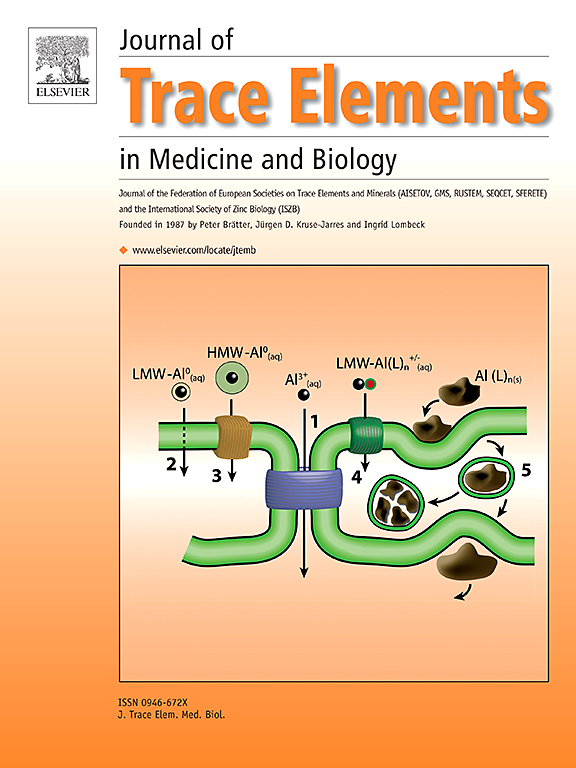Element status and inflammatory response in dogs with pyometra
IF 3.6
3区 医学
Q2 BIOCHEMISTRY & MOLECULAR BIOLOGY
Journal of Trace Elements in Medicine and Biology
Pub Date : 2025-07-10
DOI:10.1016/j.jtemb.2025.127696
引用次数: 0
Abstract
Background
Pyometra is a life-threatening disease characterized by persistent endometrial inflammation and bacterial colonization, which occur through enzymatic and non-enzymatic antioxidant mechanisms. Minerals and trace elements have effective roles in numerous metal-dependent enzyme and protein activities. The aim of this study is to evaluate the monocyte to lymphocyte ratio (MLR), neutrophil to lymphocyte ratio (NLR), white blood cell (WBC), C-reactive protein (CRP), albumin (ALB), progesterone (P4) levels, serum and uterine tissue iron (Fe), copper (Cu), selenium (Se), zinc (Zn), magnesium (Mg), manganese (Mn) concentrations and Cu/Zn ratio in dogs with pyometra and healthy controls.
Methods
This study included 43 dogs divided into two groups: a Control Group (n = 23) and a Pyometra Group (n = 20), 12 with open-cervix and 8 with closed-cervix pyometra. All animals underwent ovariohysterectomy, and intrauterine swab samples were collected for bacterial culture. Mineral analysis in serum and uterine tissue was performed using inductively coupled plasma optical emission spectrometry (ICP-OES).
Results
All dogs in this study were multiparous and at the luteal phase of the estrous stage. Isolated microbial agents in Group PYO were Gram-negative bacteria. Increase in P4 (P = 0.01), CRP, WBC, MLR, NLR, and decrease in ALB levels observed in Group PYO (P < 0.001). Significant rise in serum and uterine Cu, Fe, and Mg concentrations and decrease in serum and uterine Se and Zn concentrations were determined in pyometra cases (P < 0.001). Also, Cu/Zn ratio both in serum and uterine tissue samples were significantly higher in Group PYO than in Group C (P < 0.001).
Conclusion
Changes in CRP, WBC, MLR, NLR, P4 and ALB reflected the inflammatory response and immune deficiency in the presence of canine pyometra. Significant differences in serum and uterine Cu, Fe, Mg, Se, and Zn concentrations in pyometra cases proved that these elements can be used as non-enzymatic antioxidant biomarkers. To our knowledge, the present study explored firstly Cu/Zn ratio in canine pyometra cases as an oxidative stress biomarker. It was concluded that Mg, Cu/Zn and trace elements can be effective markers to assess the non-enzymatic antioxidant status in canine pyometra cases.
脓脓症犬的元素状态和炎症反应
脓脓症是一种危及生命的疾病,其特征是持续的子宫内膜炎症和细菌定植,这是通过酶和非酶抗氧化机制发生的。矿物质和微量元素在许多依赖金属的酶和蛋白质活性中起着有效的作用。本研究旨在评价脓脓症犬和健康对照犬的单核细胞/淋巴细胞比(MLR)、中性粒细胞/淋巴细胞比(NLR)、白细胞(WBC)、c反应蛋白(CRP)、白蛋白(ALB)、黄体酮(P4)水平、血清和子宫组织铁(Fe)、铜(Cu)、硒(Se)、锌(Zn)、镁(Mg)、锰(Mn)浓度和Cu/Zn比值。方法将43只犬分为两组:对照组(n = 23只)和子宫积脓组(n = 20只),其中开放子宫颈组12只,封闭子宫颈组8只。所有动物均行卵巢子宫切除术,并收集宫内拭子样本进行细菌培养。采用电感耦合等离子体发射光谱法(ICP-OES)对血清和子宫组织进行矿物质分析。结果本研究所有犬均为多产,处于发情期的黄体期。PYO组分离的微生物菌群为革兰氏阴性菌。PYO组P4升高(P = 0.01),CRP、WBC、MLR、NLR升高(P <; 0.001),ALB降低(P <; 0.001)。脓膜患者血清和子宫Cu、Fe、Mg浓度显著升高,血清和子宫Se、Zn浓度显著降低(P <; 0.001)。PYO组血清和子宫组织样品中的Cu/Zn比均显著高于C组(P <; 0.001)。结论CRP、WBC、MLR、NLR、P4、ALB的变化反映了犬脓子宫肿的炎症反应和免疫缺陷。脓脓患者血清和子宫中Cu、Fe、Mg、Se和Zn浓度的显著差异证明这些元素可以作为非酶促抗氧化生物标志物。据我们所知,本研究首次探索了犬脓脓病例中的Cu/Zn比率作为氧化应激的生物标志物。结果表明,Mg、Cu/Zn和微量元素可作为评价犬脓脓症非酶抗氧化状态的有效指标。
本文章由计算机程序翻译,如有差异,请以英文原文为准。
求助全文
约1分钟内获得全文
求助全文
来源期刊
CiteScore
6.60
自引率
2.90%
发文量
202
审稿时长
85 days
期刊介绍:
The journal provides the reader with a thorough description of theoretical and applied aspects of trace elements in medicine and biology and is devoted to the advancement of scientific knowledge about trace elements and trace element species. Trace elements play essential roles in the maintenance of physiological processes. During the last decades there has been a great deal of scientific investigation about the function and binding of trace elements. The Journal of Trace Elements in Medicine and Biology focuses on the description and dissemination of scientific results concerning the role of trace elements with respect to their mode of action in health and disease and nutritional importance. Progress in the knowledge of the biological role of trace elements depends, however, on advances in trace elements chemistry. Thus the Journal of Trace Elements in Medicine and Biology will include only those papers that base their results on proven analytical methods.
Also, we only publish those articles in which the quality assurance regarding the execution of experiments and achievement of results is guaranteed.

 求助内容:
求助内容: 应助结果提醒方式:
应助结果提醒方式:


